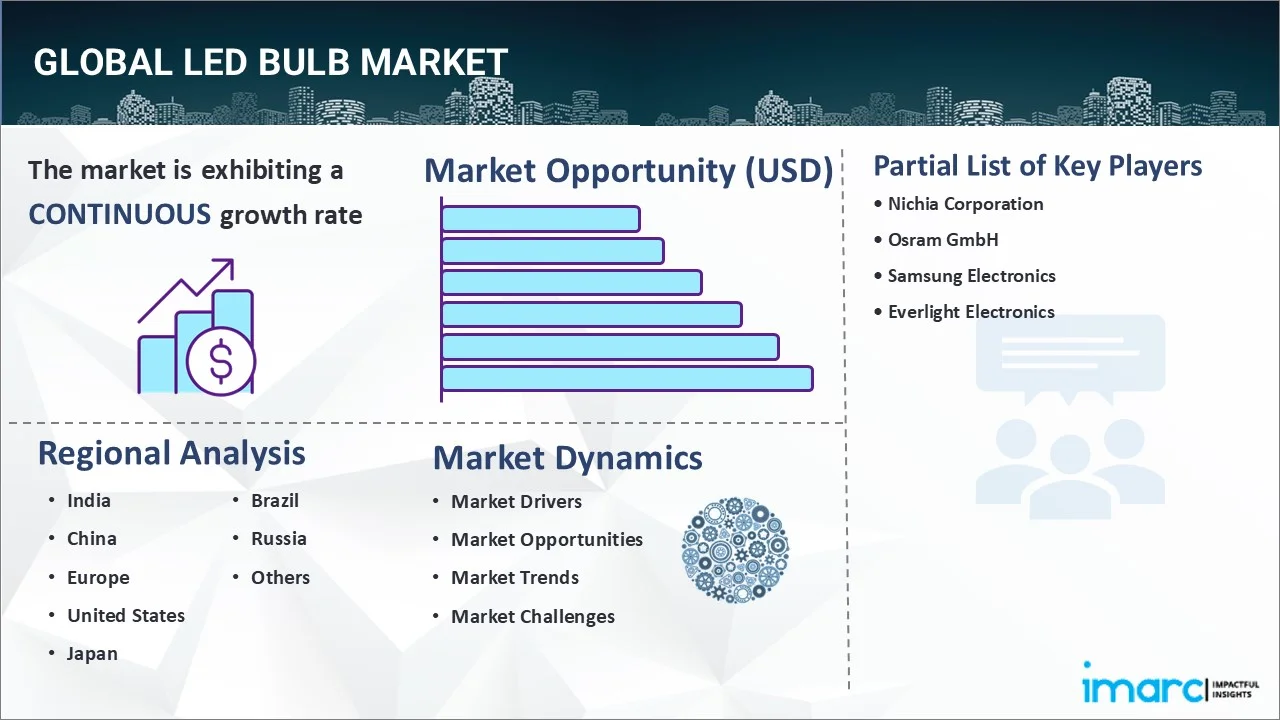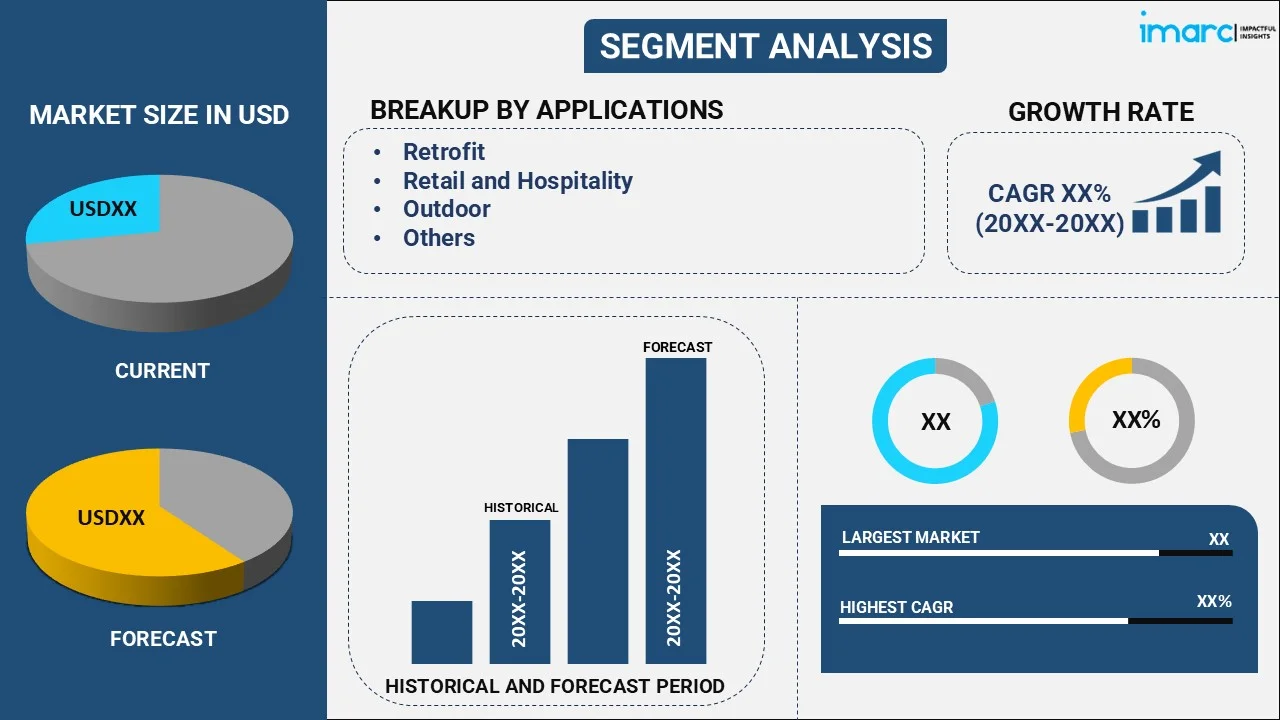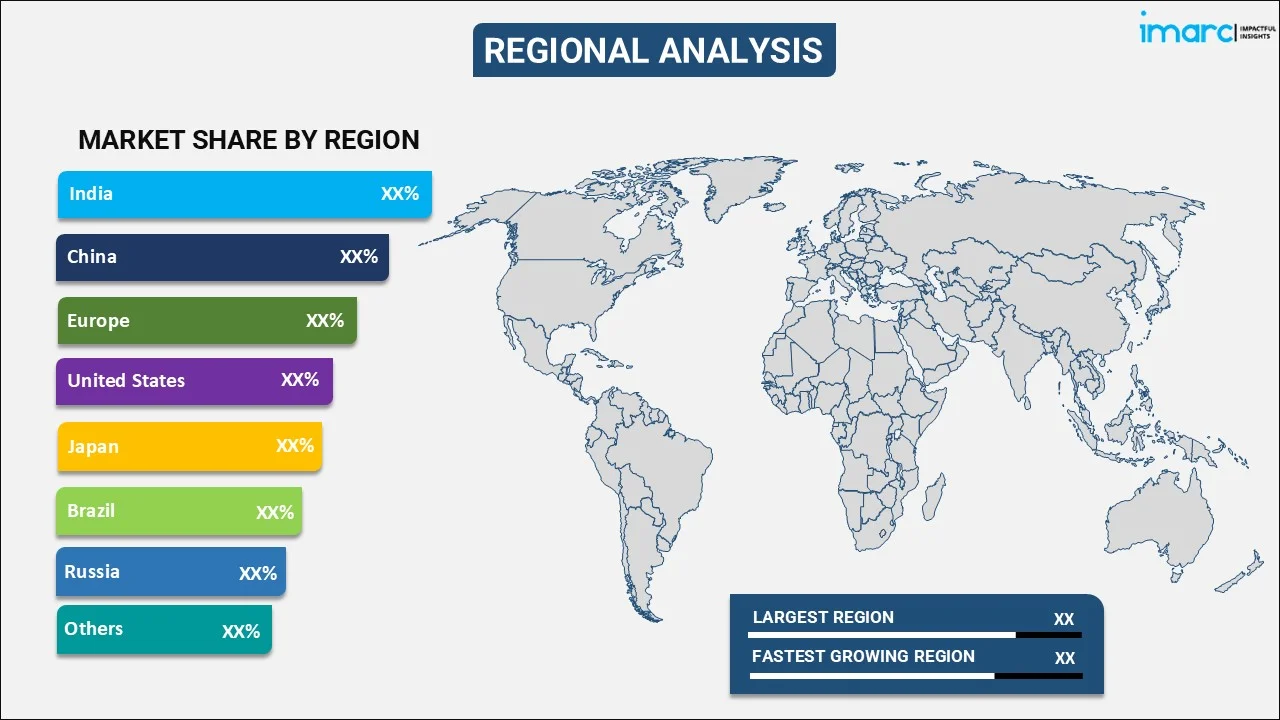
LED Bulb Market Report by Application (Retrofit, Retail and Hospitality, Outdoor, Offices, Architectural, Residential, Industrial), and Region 2025-2033
Global LED Bulb Market Size:
The global LED bulb market size reached USD 10.2 Billion in 2024. Looking forward, IMARC Group expects the market to reach USD 24.0 Billion by 2033, exhibiting a growth rate (CAGR) of 9.85% during 2025-2033. The emerging smart lighting trends, the launch of favorable policies by government bodies promoting energy-saving solutions, and the rising popularity of customization options are some of the key factors stimulating the global market for LED bulbs.
|
Report Attribute
|
Key Statistics
|
|---|---|
|
Base Year
|
2024 |
|
Forecast Years
|
2025-2033
|
|
Historical Years
|
2019-2024
|
| Market Size in 2024 | USD 10.2 Billion |
| Market Forecast in 2033 | USD 24.0 Billion |
| Market Growth Rate 2025-2033 | 9.85% |
Global LED Bulb Market Analysis:
- Major Market Drivers: The increasing consumer environmental concerns are prompting a shift towards energy-efficient lighting solutions, such as LED bulbs. Moreover, as they have a longer lifespan and lower energy consumption, the global LED bulb market demand is elevating significantly. Besides this, the rising popularity of customizable and aesthetically pleasing lighting solutions in commercial, residential, and industrial sectors is expected to bolster the scope of the LED bulb industry in the future.
- Key Market Trends: The LED bulb industry's top manufacturers are focusing on integrating advanced technologies to improve efficiency, minimize costs, and enable a wide array of product variants accessible, thereby enhancing their appeal to businesses and customers. Besides this, the development of smart lighting systems, where LEDs can be easily controlled via smartphones and other devices, is also fueling LED bulb manufacturing across the globe.
- Competitive Landscape: Some of the major market players in the global LED bulb industry include Nichia Corporation, Osram GmbH, Samsung Electronics, and Everlight Electronics, among many others.
- Geographical Trends: India accounted for the largest country in the LED bulb market. The efforts by government bodies in the country through policies, including Unnat Jyoti by Affordable LEDs for All (UJALA), are acting as significant growth-inducing factors. Furthermore, frequent blackouts and power fluctuations in certain areas have increased the reliability of individuals on LED bulbs, as they can be operated efficiently in low voltage.
- Challenges and Opportunities: The supply chain of LED bulbs is complex and often requires sourcing from various countries. Consequently, disruptions in the supply chain, owing to trade disputes and geopolitical tensions, can lead to product shortages and increased costs, thereby hindering the market growth. Furthermore, the rising number of large key players can also lead to challenges in standardizing LED bulbs. However, numerous factors, such as favorable regulatory policies, strategic innovations, and global certifications, are anticipated to fuel the LED bulb market business opportunity.

To get more information on this market, Request Sample
Global LED Bulb Market Trends:
The Rising Consumer Environmental Concerns and the Growing Emphasis on Energy-Efficiency
Individuals across the globe are focusing on environmental sustainability and energy efficiency, owing to the elevating consumer awareness towards the detrimental effects of greenhouse emissions. Consequently, they are widely using LED bulbs, which is providing significant opportunities to the LED bulb industry outlook. For instance, in July 2023, Signify Malaysia introduced a whole range of sustainable and energy-efficient lighting products for the Malaysian market. These products included Philips Ultra Efficient LED and Philips Solar Lighting solutions. Philips Ultra Efficient LED has advanced LED design and optics technology, consisting of a range of LED bulbs and LED tubes that consume 60% less energy than standard LED products of the same category. Moreover, it could deliver up to 50,000 hours of light and more than 3.5x the lifetime usage. In line with this, the Philips Solar Lighting range has a selection of solar products, such as solar wall lights, solar flood lights, solar garden or landscape lighting products, and others. Furthermore, government bodies are launching favorable policies, which is significantly propelling the LED bulb market share. For example, in June 2023, government bodies in the United States collaborated with the U.S. Department of Energy (DOE) to facilitate energy enhancements in K-12 schools nationwide. They have funded US$ 178 Million. This financial support helped these education facilities to undertake projects that were focused on minimizing energy expenditures, reducing emissions levels, developing enhanced LED lighting solutions, etc.
The Rising Technological Advancements and Cost-Reduction
According to the LED bulb industry report, leading advancements, including continuous innovations in LED heat dissipation systems, chip design, optical components, etc., are resulting in higher lumens per watt (efficacy) and longer lifespans. This, in turn, is bolstering the market growth. For instance, Philips introduced the WiZ Smart Lighting, which can be controlled through Wi-Fi. This range further developed SpaceSense, the latest in motion sensing technology. In addition to this, General Electric announced that its smart LED bulbs series C had been integrated to work with Google Home devices via a Bluetooth connection, which could help consumers to control lighting through voice commands. Extensive investments in R&D activities have also led to cost reductions. Moreover, the rising need for affordable housing products, owing to the policies launched by government bodies, is also positively influencing the LED bulb market growth. For instance, in India, new product developments in the Mumbai Metropolitan Region (MMR) increased over two-fold to 1,24,652 units. In India, the government has introduced several energy-saving programs. For example, the central government introduced the Pradhan Mantri Awas Yojana (PMAY) program, which was aimed at building 20 million affordable metropolitan housing units nationwide. Additionally, the president in Brazil also announced plans to restart the nationwide federal housing program for low-income individuals in February 2023. It was created by the program, named “Minha Casa, Minha Vida,” which translates to “My Home, My Life,”. Such instances elevated the demand for LED lighting in the country.
The Elevating Popularity of Smart Lighting and Customization Options
Leading players are introducing smart lightning solutions and customization options. Moreover, the widespread adoption of the Internet of Things (IoT) is bolstering the growth of connected smart lighting systems in China. GSMA estimates that China may account for around 4.1 billion IoT connections, which is almost one-third of the worldwide IoT connections, by 2025. In line with this, in February 2023, Signify helped the German municipality of Eichenzell become a future-proof smart city through intelligent street lighting. Its BrightSites solution enabled Eichenzell to cater to next-generation IoT applications and future 5G densification. Signify installed LED lighting, which the Interact City System manages. Eichenzell can continuously monitor and manage all lights from a single dashboard. Furthermore, in January 2023, Savant company GE Lighting announced the expansion of its smart home ecosystem, called Cync. Cync launched its entire Dynamic Effects entertainment lineup, which included 16 million pre-sets, colors, and custom light shows, on-device music syncing, and other features. These advancements and partnerships are expected to bolster the market growth over the forecasted period.
Global LED Bulb Market Segmentation:
IMARC Group provides an analysis of the key trends in each segment of the market, along with forecasts at the global and regional level for 2025-2033. Our report has categorized the market based on application.
Application Insights:

- Retrofit
- Retail and Hospitality
- Outdoor
- Offices
- Architectural
- Residential
- Industrial
The report has provided a detailed breakup and analysis of the market based on the application. This includes retrofit, retail & hospitality, outdoor, offices, architectural, residential, and industrial. According to the report, retrofit represented the largest segment. The escalating demand for LED retrofits, as they contribute to energy-savings as compared to conventional counterparts, is catalyzing the market growth. LED retrofits, when integrated as smart lighting solution, can minimize electricity bills and minimize environmental impact.
Regional Insights:

- India
- China
- Europe
- United States
- Japan
- Brazil
- Russia
- Others
The market research report has also provided a comprehensive analysis of all the major regional markets, which include India, China, Europe, the United States, Japan, Brazil, Russia, and others. According to the report, India accounted for the largest market share. India is becoming a major manufacturing hub in the world with its aim to export US$ 1 Trillion worth of goods by 2030. Furthermore, the implementation of various programs and policies, such as the National Manufacturing Policy, which aims to increase the manufacturing share of GDP to 25% by 2025, will continue to bolster the market across the country. Besides this, the escalating demand for industrial lighting in warehousing, logistics, industrial operations, etc., is also bolstering the market growth. For instance, the Warehousing, Industry, and Logistics (WIL) category in India is expected to become a US$ 5 Trillion economy by FY 2025. These factors are growing the sales of LED lighting in domestic warehouses and industries. Besides this, Signify Inc., a manufacturer and designer of commercial & residential lighting solutions, introduced its 3D printed downlight LED lighting range in the Indian market. The product variants are eco-friendly and are made from recycled polycarbonate, which is beneficial for the environment.
Competitive Landscape:
The market research report has also provided a comprehensive analysis of the competitive landscape in the market. Competitive analysis such as market structure, key player positioning, top winning strategies, competitive dashboard, and company evaluation quadrant has been covered in the report. Also, detailed profiles of all major companies have been provided. Some of the major market players in global LED bulb industry include:
- Nichia Corporation
- Osram GmbH
- Samsung Electronics
- Everlight Electronics
(Please note that this is only a partial list of the key players, and the complete list is provided in the report.)
Global LED Bulb Market News:
- March 2024: The Energy Efficiency Services Limited (EESL), a joint venture under the Ministry of Power (GoI), announced the expansion of its energy efficiency portfolio with the introduction of 5-star rated 6-watt LED bulbs. As part of its ongoing commitment to advancing the goals of Unnat Jyoti by Affordable LEDs for All (UJALA) program, EESL's venture revolutionized India's energy consumption landscape.
- October 2023: Halonix Technologies, one of India's fastest-growing electrical companies, introduced India's first 'UP-DOWN GLOW' LED Bulb, which provided a consistent look to the ambiance in the room.
- February 2023: Signify helped the German municipality of Eichenzell become a future-proof smart city through intelligent street lighting. Its BrightSites solution offered a fast, wireless broadband connectivity to the city, allowing Eichenzell to cater to next-generation IoT applications and future 5G densification.
LED Bulb Market Report Scope:
| Report Features | Details |
|---|---|
| Base Year of the Analysis | 2024 |
| Historical Period | 2019-2024 |
| Forecast Period | 2025-2033 |
| Units | Billion USD |
| Scope of the Report | Exploration of Historical Trends and Market Outlook, Industry Catalysts and Challenges, Segment-Wise Historical and Predictive Market Assessment:
|
| Applications Covered | Retrofit, Retail and Hospitality, Outdoor, Offices, Architectural, Residential, Industrial |
| Regions Covered | India, China, Europe, Japan, Brazil, Russia, United States, Others |
| Companies Covered | Nichia Corporation, Osram GmbH, Samsung Electronics, Everlight Electronics, etc. |
| Customization Scope | 10% Free Customization |
| Post-Sale Analyst Support | 10-12 Weeks |
| Delivery Format | PDF and Excel through Email (We can also provide the editable version of the report in PPT/Word format on special request) |
Key Benefits for Stakeholders:
- IMARC’s report offers a comprehensive quantitative analysis of various market segments, historical and current market trends, market forecasts, and dynamics of the LED bulb market from 2019-2033.
- The research study provides the latest information on the market drivers, challenges, and opportunities in the global LED bulb market.
- Porter's five forces analysis assist stakeholders in assessing the impact of new entrants, competitive rivalry, supplier power, buyer power, and the threat of substitution. It helps stakeholders to analyze the level of competition within the LED bulb industry and its attractiveness.
- Competitive landscape allows stakeholders to understand their competitive environment and provides an insight into the current positions of key players in the market.
Key Questions Answered in This Report
The global LED bulb market was valued at USD 10.2 Billion in 2024.
We expect the global LED bulb market to exhibit a CAGR of 9.85% during 2025-2033.
The rising demand for LED bulbs in the industrial, commercial, and residential sectors as energy-efficient and eco-friendly lighting solutions, is primarily driving the global LED bulb market.
The sudden outbreak of the COVID-19 pandemic had led to the implementation of stringent lockdown regulations across several nations, resulting in the temporary closure of numerous manufacturing units for LED bulbs.
Based on the application, the global LED bulb market can be bifurcated into retrofit, retail and hospitality, outdoor, offices, architectural, residential, and industrial. Currently, retrofit exhibits a clear dominance in the market.
On a regional level, the market has been classified into India, China, Europe, United States, Japan, Brazil, Russia, and others, where India currently dominates the global market.
Some of the major players in the global LED bulb market include Nichia Corporation, Osram GmbH, Samsung Electronics, Everlight Electronics, etc.
Need more help?
- Speak to our experienced analysts for insights on the current market scenarios.
- Include additional segments and countries to customize the report as per your requirement.
- Gain an unparalleled competitive advantage in your domain by understanding how to utilize the report and positively impacting your operations and revenue.
- For further assistance, please connect with our analysts.
 Request Customization
Request Customization
 Speak to an Analyst
Speak to an Analyst
 Request Brochure
Request Brochure
 Inquire Before Buying
Inquire Before Buying




.webp)




.webp)












